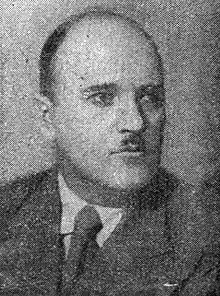Avraami Zavenyagin
Lieutenant-General Avraami Pavlovich Zavenyagin (1 May 1901, Uzlovaya – 31 December 1956; his first name is also sometimes given as Avram or Abraham) was a leading figure in the Soviet nuclear projects of the 1940s and 1950s.[1][2][3] [4]
Avraami Pavlovich Zavenyagin Авраамий Павлович Завенягин | |
|---|---|
 | |
| Minister of Medium Machine Building | |
| In office 28 February 1955 – 31 December 1956 | |
| Premier | Nikolai Bulganin |
| Preceded by | Vyacheslav Malyshev |
| Succeeded by | Mikhail Pervukhin |
Zavenyagin was made plant director of the Magnitogorsk Iron and Steel Works in August 1933 and served in that capacity until 1936 when he was appointed the assistant to the People's Commissar of Heavy Industry [4].
A protégé of Lavrenti Beria,[2] Zavenyagin survived the purge after the death of Joseph Stalin because of a long friendship with Nikita Khrushchev, which dated back to the 1920s. During the Khrushchev era, he headed the Ministry of Medium Machine Building, responsible for nuclear weapons production, for two years. He died of a heart attack in 1956.
References
- Antony Beevor, The fall of Berlin, 1945, 2002
- Richard Lee Miller, Under the cloud: the decades of nuclear testing, 1986
- George A. Lopez and Nancy J. Myers, Peace and security: the next generation, 1997
- John Scott, Behind the Urals: an American worker in Russia's City of Steel, 1942